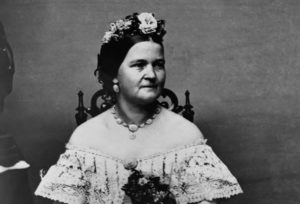Last week, we learned about Abe Lincoln’s personal debt problem and how he got out from under it. In the next part of this series celebrating Presidents’ Day, we’ll be taking a look at how one of the most famous First Ladies fell under the spell of compulsive shopping and retail therapy, growing her consumer debt and creating all kinds of credit problems (and political problems) for herself and her husband.
Mary Todd Lincoln, married to the 16th president, Abraham Lincoln, had a taste for the finer things in life (https://www.mrlincolnswhitehouse.org/). Feeling the scrutiny from the media as a fashion symbol, she felt the need to spend exorbitant amounts of money on clothing and accessories. At one point, she purchased 400 pairs of gloves in a four month period. She also overindulged in the redecorating process of the White House, lobbying Congress for $20,000 (almost the same amount as the presidential salary) to refurbish the mansion, and ended up over budget by nearly $7,000. While she often received items as gifts, she still did not have a long-term plan to pay for those that were not gifted to her.
“I must dress in costly materials,” she said to a friend. “The President glances at my rich dresses and is happy to believe that the few hundred dollars that I obtain from him supply all my wants…if he is elected, I can keep him in ignorance of my affairs, but if he is defeated [in the reelection], then the bills will be sent.” After the death of her son Willie in 1862, her mourning sent her into more debt as she went on clothes shopping sprees to nullify her grief.
By 1864, her debts had run up to $27,000, nearly $400,000 in today’s money. President Lincoln was furious, causing arguments and problems in their marriage. Desperate, she would share political secrets with officials or promise political favors in exchange for loans. She even sold off excess manure purchased to fertilize White House grounds, and fired mansion staff to save money. She and her husband were fortunate that the White House expenses used to pay off her debt were kept secret during Lincoln’s 1864 reelection campaign.
After the death of her husband, creditors descended upon the fragile woman. They had previously granted unlimited credit, and now demanded payment. Congress granted her a one-time pension payment of $25,000, but it was not enough to cover her debts or spending habits. She ended up selling many of her personal belongings, and her supporters helped as much as they could. Though she eventually paid off her debts, swirling rumors and the actions she took to secure personal loans ruined her reputation and relationship with many friends.
Of course, her personal debt aside, Mary Todd Lincoln was one of the most influential First Ladies in the White House. She helped women gain employment in the government, and backed a female nursing corps. She was the first to welcome African-Americans as guests in the White House, and her interest and advocacy of the abolition of slavery was progressive for her times. But while she was accomplishing these goals, she was still always under the burden that so many people feel today.
Mrs. Lincoln’s attitude towards credit and material possessions is one that we can all understand and still see today. Like many Americans today, she was a shopaholic. She had no long-term plan on how to pay off her debts, and the schemes she came up with to pay off the debts caused rifts in her marriage and relationships with friends. It must have caused quite a shock to Honest Abe to find out what his wife had been up to.
If this situation sounds familiar to you, please don’t wait another day to get debt advice on debt relief or debt reduction.
You’re not alone if you’re struggling with debt. Schedule a free credit counseling session with us today.






